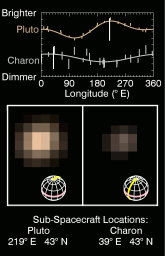This series of images taken by NASA's New Horizons' Multispectral Visible Imaging Camera (MVIC) shows how Pluto and Charon change in brightness as they rotate over 6.4 Earth days.The central panel shows the true color of Pluto (left) and Charon (right) during nine epochs between May 29 May and June 3 2015, as the spacecraft approached the Pluto system from a range of 55 to 48 million km.The grids beneath the images show the orientations of Pluto and Charon, with 0° E longitude and the equator highlighted by the yellow and pink lines respectively.Sub-spacecraft locations on Pluto and Charon are listed at the bottom.The spatial resolution, at around 1000 km/pixel, is not yet sufficient in these images to reveal distinct surface features on either body.
The top panel shows in graphical form how the brightness in MVIC's red channel (540-700 nm) varies with the sub-spacecraft longitude, including data from more distant images dating back to May 1.The moving white vertical lines indicate the observed central longitudes on Pluto and Charon as the images below rotate.These results are consistent with earlier Hubble Space Telescope observations of the lightcurves of Pluto and Charon.Pluto appears dimmest when the dark region on its trailing hemisphere (around 90° E) is oriented toward the observer and brighter when the dark area has rotated off the visible hemisphere and a bright region on the anti-Charon hemisphere is seen.A different, lower amplitude lightcurve variation is seen on Charon, where the Pluto-facing hemisphere (around 0° E) appears brighter than the anti-Pluto hemisphere.
New Horizons is the first mission to Pluto and the Kuiper Belt of rocky, icy objects beyond.Principal Investigator Alan Stern leads a mission team that includes the Johns Hopkins University Applied Physics Laboratory, Southwest Research Institute, Ball Aerospace Corporation, the Boeing Company, NASA Goddard Space Flight Center, NASA Jet Propulsion Laboratory, Stanford University, KinetX, Inc., Lockheed Martin Corporation, University of Colorado, the U.S. Department of Energy, and a number of other firms, NASA centers, and university partners. Visit the mission website http://pluto.jhuapl.edu/ for more information.

 Planetary Data System
Planetary Data System












